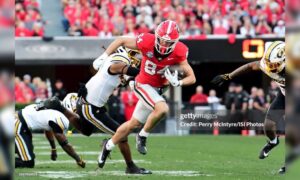By Matthew Marczi
“Time to die” is the text that got former Pittsburgh Steelers running back Chris Rainey in trouble back in 2010. It was a text message to his girlfriend that led to a felony stalking charge that was later knocked down to a misdemeanor after Rainey agreed to take an anger management course and perform community service.
It was a text message that damaged his stock in the 2012 NFL Draft, which, combined with his diminutive size, knocked him all the way into the fifth round, which had analysts such as Mike Mayock decreeing him one of the steals of the draft.
Of course, the regular season did not exactly bear that out. Though Rainey’s play was not terrible, it was most certainly expendable. He finished the season with 26 rushing attempts for 102 yards and two touchdowns, adding 60 receiving yards on 14 receptions. He also fumbled four times, losing one. He averaged 26.5 yards on 39 kick returns and 5.3 yards on three punt returns.
When it turned out that Rainey was involved in another domestic dispute early this past offseason, which resulted in an arrest for simple battery that was later reduced to disorderly conduct, the Steelers were quick to act, releasing him the same day.
Why, then, when Alameda Ta’amu was arrested in October for a very public and very dangerous night on the town that involved drunk driving and evading arrest, was he not treated in a similar manner? Ta’amu, a fourth round draft pick from the same class as Rainey, also had prior legal trouble of the same sort as his latest incident, and in fact spent nearly the entire season inactive.
The rookie nose tackle received a two-game suspension that the team itself imposed, and upon serving the suspension, was only signed back to the practice squad, although he was later promoted by the end of the season.
So why would the Steelers treat two players from the same draft class, both with prior issues and similarly unspectacular production on the field, in a different manner? A lot of it has to do with character. The Steelers clearly believed that Ta’amu’s incident was more out of his character than was Rainey’s. But there is also potential to consider.
Despite the fact that the Steelers—and more particularly its fans, myself included—like to portray the organization as a sort of family first, high character outfit (and by professional sports league standards, it very much is), the reality is that the Steelers run a business just like every other team, and that requires making business decisions. The handling of Rainey and Ta’amu reflect those business decisions in action.
Let me be clear: this is in no way to diminish the Steelers in any sense. If anything, it is a promotion of their acute business sense, which is essential for the team’s success both on and off the field.
There is a reality among professional athletes that many often do not want to address, and that is that most of them come from disadvantaged upbringings, during which they encounter a wide array of obstacles that many people in more privileged circumstances are able to avoid. One need merely listen to the backstories of players already in the Steelers locker room to get a sense of this, such as Antonio Brown, Jerricho Cotchery, William Gay, Curtis Brown, or Jarvis Jones.
That is why phrases such as “off-field issues” and “character concerns” are as much a part of the pre-draft lexicon as are “high motor” and “quicker than fast”. Wading through a draft class with an ear toward character is like walking through a minefield for general managers around the league, and each team has its own scale of risks and rewards on individual cases.
The Steelers took a number of perceived gambles last year with Rainey, Ta’amu, and, most significantly, offensive tackle Mike Adams, who is projected as the starter at right tackle in his sophomore season. Of course, it helped that Adams’ crimes were, at best, smoking marijuana and being stupid enough to do it close enough to be caught with it in his system at the combine.
It helped that he took the initiative to reach out to the organization and explain his situation. Adams has been nothing short of genial when speaking with the media since his arrival in Pittsburgh. The worst that he’s done since becoming a Steeler was staying out late, which resulted in him being assaulted with a knife, landing him in the hospital.
To balance out the ‘risks’, the Steelers also selected a number of “high character” individuals in 2012, starting with first round pick David DeCastro and ending with Kelvin Beachum as a compensatory seventh round selection.
One need only take a look at any sports media outlet to see what an organization potentially exposes itself to when taking a risk on an athlete, which the New England Patriots did in 2010 with their selection of tight end Aaron Hernandez, who is currently not ruled out as a suspect for murder.
So how have the Steelers navigated their own turbulent waters over the years, and in particular during the Kevin Colbert era? Before considering that, it is first necessary to look back at the Steelers\’ historical legacy, how the team became a reflection of the Rooney family’s values, and how they handled their own once upon a time with Ernie “Fats” Holmes back in 1973.







